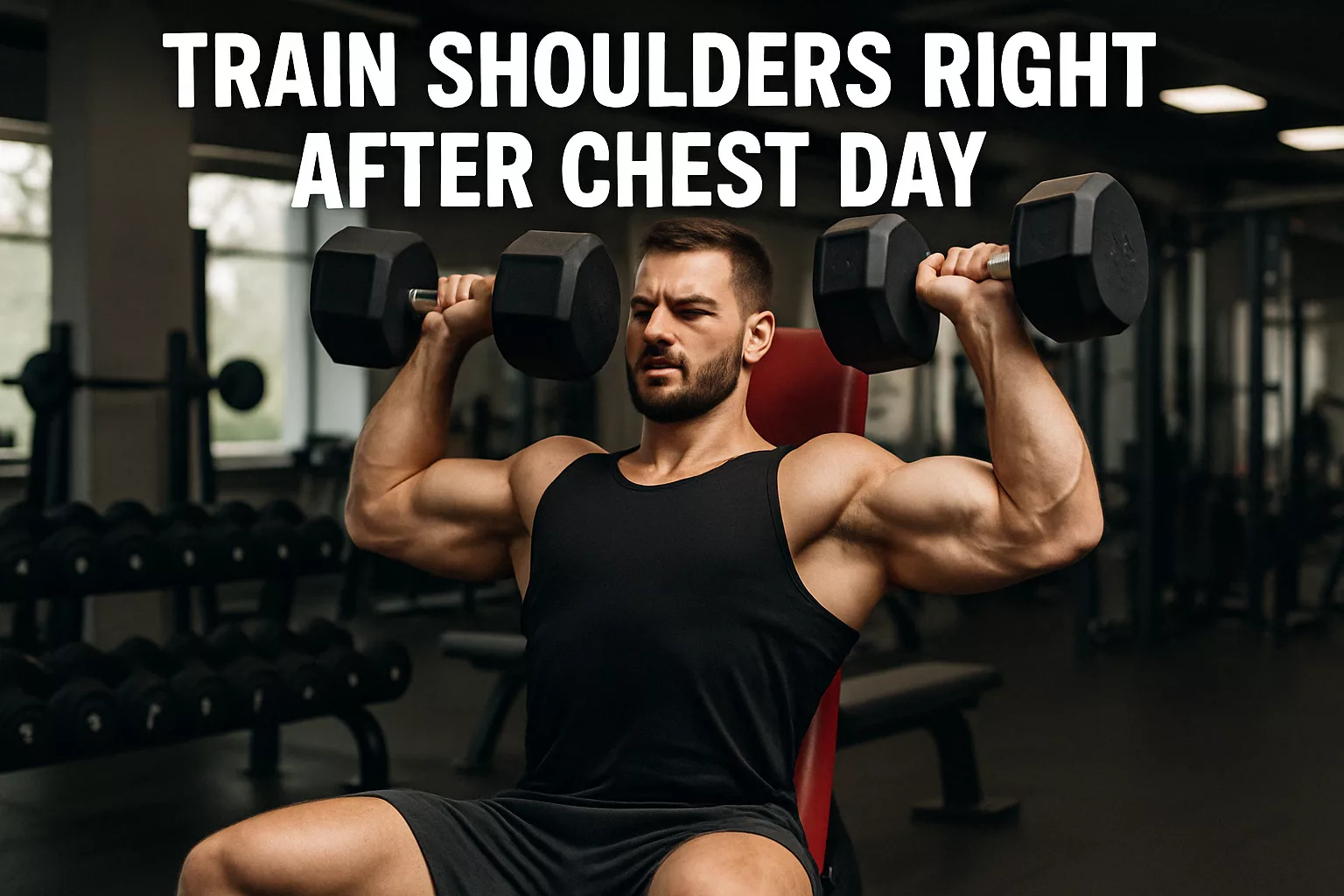Ah, the old locker room question, the one every gym enthusiast has asked themselves at least once in front of the mirror with headphones in and a shaker bottle half full of protein.
“Tomorrow I train shoulders even though today I pushed like crazy on chest?”
Well, take a moment.
Because behind that simple question lies a world of biomechanics, muscle recovery, and programming strategies that can make the difference between linebacker shoulders…
…and a tendinitis that will haunt you all summer.
I learned this lesson the hard way.
Literally.
That sweet deception of “if it doesn’t hurt, I’m all good.”
Let’s start from here.
If today you did bench press, maybe incline bench as well, some dips, and a couple of flyes to finish off beautifully…
you have already asked a lot of your anterior shoulders (the front ones, just to be clear).
Yes, I know it was “chest day.”
But the anterior deltoid doesn’t know that.
It saw a series of pushing movements and took on, often without you even noticing, a good amount of work.
It is there that it holds, stabilizes, participates… suffers in silence.
And what do you say to it the next day?
“Hey, deltoid, good morning! Today we’re doing barbell shoulder press, lateral raises, and maybe even a bit of Arnold press to show off.”
Response?
It sends you packing.
But it does so with inflammation.
Understanding How the Shoulder Really Works (and Why It Needs to Be Treated Well)
The shoulder is one of those fancy joints.
Super mobile, super useful… and super prone to getting hurt.
It is a complex joint, composed of small muscles that work together to provide stability and precision in movements.
When you train chest, the anterior shoulder is already under stress.
When the next day you train shoulders, very often you insist on that small muscle group that is already tired.
It is like asking a colleague to work overtime…
after he has just finished a night shift.
And sure, maybe the guy doesn’t complain…
but sooner or later, he gives up.
The Science Says: Take It Easy, Bro
Studies on muscle protein synthesis show that after an intense workout, muscles need about 48–72 hours to recover and rebuild.
If you train synergistic muscles (that is, muscles that work together), like chest and anterior shoulders, on two consecutive days, you interrupt that recovery process.
Not only do you risk limiting growth, but you can also increase the possibility of injuries—especially in the long term.
And nothing slows your gains like a month off due to inflammation of the supraspinatus, trust me from personal experience after spending July with an elastic band instead of a barbell.
But what if you’re a recovery monster?
Okay, let’s say you’re genetically blessed.
You have the metabolism of a teenager, sleep like a log, eat clean, and are as hydrated as an organic cucumber.
You also have the stretching routine, the foam roller, the ice…
Then yes, you might get by.
But even in that case, is it really the best choice?
Because there’s a difference between “I can do it” and “it’s in my best interest to do it.”
Smart programming always wins over brute strength.
You can get better results by moving your shoulder workout by a day or two.
And if you really don’t want to separate them…
at least choose your exercises more wisely.
Training Smart: Alternatives That Save the Deltoid
Here are a couple of strategies to use when the week is short or you have to squeeze everything into a few days:
- Push/Pull/Legs split: Chest on Monday, back on Tuesday, shoulders on Wednesday.
Perfect time to recover.
(Legs? Scheduled. Arms? Handled. But this one’s all about shoulder survival after chest day.)
- Upper/Lower split: Chest and shoulders on the same day. Yes, all together.
(The rest of the upper body tags along—arms included. Legs get their own day, don’t worry.)
- Full body with a rotation focus: One day emphasize the chest, another the shoulders.
Less volume per muscle group, but higher frequency.
(Arms work in the mix too, just with smarter timing.)
And if you really have to train shoulders the day after chest?
Focus on lateral and posterior deltoids, and skip the heavy pressing.
You’ve already done those.
Give them a break.
And for those with little time and a huge hunger for results?
I get it.
Not everyone has the luxury of six days a week in the gym.
If you only have three days available, it’s okay to combine chest and shoulders.
But watch the total volume.
- Reduce overlapping exercises.
- Boost recovery: sleep well, eat better, supplement if necessary.
Even one less day, if well programmed, can yield results.
The key is that the quality of the workout matters, not just the quantity.
The naked, unvarnished truth?
It all depends on how you do it.
It isn’t training shoulders after chest that kills your progress.
It’s how you do it.
If you ignore your body’s signals, repeat the same patterns, load maximal weights on already stressed muscles…
yes, you’re sabotaging your results.
But if you plan, listen to your body, and vary the stimuli intelligently…
it can work.
The key is not to treat the workout like an assembly line, but like a puzzle.
Every piece has to fit.
My Approach: Chest First, Then Shoulders
When I train chest and shoulders together, I always start with chest.
Because the more complex and heavy pushing movements require energy and stability.
After exhausting the pectoralis major, I move on to shoulders.
That way, the deltoids work secondarily during chest exercises and then take center stage on shoulder day.
It is a logical sequence that has allowed me to avoid fatigue and stagnant gains.
Ideal Rep Range for Combined Chest and Shoulder Workouts
For chest: 6–12 repetitions.
For shoulders: 8–15 repetitions.
With this range, you balance strength and hypertrophy.
You train both fast-twitch and slow-twitch fibers, ensuring a complete stimulus.
If you’re aiming for pure strength, stick to 4–6 for chest.
If you’re after definition, shift the focus to 12–15 for shoulders.
Which Other Muscle Group to Add?
Chest and shoulders pair well with triceps.
They are synergistic in pushing movements.
A complete push day can include:
- Flat bench press
- Military press
- Dips
- Lateral raises
- French press
This way you maximize synergy and recover together.
Weekly Frequency for Chest-Shoulder Training
For most trainees, 1–2 times per week is optimal.
One intense session, then 48–72 hours of rest.
If you’re advanced, you can go up to 3 times, adjusting volume and intensity.
The secret is to listen to your body and calibrate the load.
Classic Exercises for Chest and Shoulders Throughout the Week
Chest: flat bench press, incline bench press, flyes on the bench, parallel bar dips.
Shoulders: military press, lateral raises, front raises, face pulls, rear delt fly.
Distribute 3–4 exercises per muscle group.
Maintain 3–4 sets of 6–15 repetitions.
Other Ways to Combine Chest with Other Muscles
- Chest and back: antagonists, perfect for supersets.
- Chest and legs: full-body day, maximum frequency and overall recovery.
- Push/Pull mix: a bit of chest, a bit of back, a bit of shoulders.
Complete Weekly Plan
Here is a schedule I often use:
Monday – Push
- Flat bench press
- Military press
- Dips
- Lateral raises
- Rear delt fly
- French press
- Rope pushdowns
(Great balance of chest, shoulders – all three heads – and triceps. Perfect start.)
Tuesday – Active Rest
- Stretching
- Foam rolling
(Helps recovery from push day and preps for pull work.)
Wednesday – Pull
- Pull-ups
- Rowing
- Face pulls
- Barbell curls
- Concentration curls
- Incline curls
(Hits all back angles + solid biceps volume.)
Thursday – Legs
- Squat
- Romanian deadlift
- Leg curl
- Calf raise
(Posterior chain and quads balanced. Good recovery gap before and after.)
Friday – Rotational Full Body
- Incline bench press
- Reverse pull-ups
- Lunges
- Front raises
(Light push/pull/legs integration with minimal overlap. Keeps frequency high, volume low.)
Saturday – Rest or Light Cardio
(Optional movement without taxing recovery.)
Sunday – Rest
(Full recovery to reset before next week.)
The naked, unvarnished truth?
It doesn’t matter if you train shoulders after chest.
It’s how you manage volume, intensity, and recovery.
RELATED》》》 Can Overtraining Delts Make My Bench Press Progress Worse?
Conclusion
Want big, round, three-dimensional shoulders?
Then train them, yes… but respect them.
Don’t turn them into a meat grinder just to chase that “pump” feeling.
Remember:
the muscle grows when it rests,
not when you squeeze it like a lemon without mercy.
If you really want to crush it, you don’t just have to train hard.
You have to train smart.



